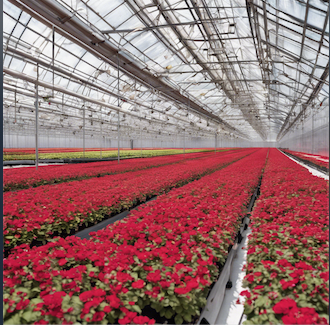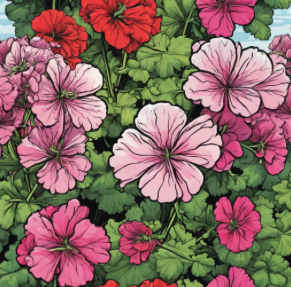
How to Grow Best Blooming Geraniums
7 Tips Grow Best Geraniums
Growing hte biggest blooming geraniums in hanging baskets or large containers can be a beautiful addition to your garden or outdoor space. Here are 7 tips for growing the best geraniums in such containers, along with how to keep the soil moist during hot weather:
Don't let rain touch the blooms AND, protect from harsh weather. The better you can maintain greenhouse growing conditions, the better they look.
Choose the Right Container:Opt for containers that are large enough to accommodate the root system of the geraniums. Hanging baskets with proper drainage holes or large containers with adequate drainage are ideal.
Use Quality Potting MixGeraniums prefer well-draining soil. Use a high-quality potting mix that is specifically formulated for container gardening. Avoid heavy garden soil, as it can lead to poor drainage and root rot.
Select Right VarietyThere are various types of geraniums available, including zonal, ivy-leaved, and scented varieties. Choose a variety that is well-suited for hanging baskets or containers. Ivy-leaved geraniums, for example, trail beautifully over the edges of containers.

Provide Adequate Sunlight
Geraniums thrive in full sun to partial shade. Place your hanging baskets or containers in a location where they will receive at least 6-8 hours of sunlight per day.
Water RegularlyGeraniums prefer evenly moist soil. Water your plants regularly, especially during hot weather, to keep the soil consistently moist but not waterlogged. Check the moisture level of the soil regularly and adjust your watering schedule accordingly.
Keep Watered During Hot WeatherDuring hot weather, it's essential to pay extra attention to keeping the soil moist to prevent your geraniums from drying out. Here are some additional tips: Water Early or Late: Water your geraniums early in the morning or late in the afternoon to minimize water loss through evaporation
MulchApply a layer of organic mulch, such as straw or shredded bark, on the surface of the soil to help retain moisture. Mulch also helps to regulate soil temperature and suppress weed growth.
Fertilizer Types:Feed your geraniums with a balanced liquid fertilizer diluted to half strength every 2-4 weeks during the growing season. Too much fertilizer can lead to excessive foliage growth at the expense of flowers, so avoid over-fertilizing.
Pelleted
Other Considerations
There are several soil additives you can incorporate into your potting mix to improve moisture retention. These additives help to increase water retention in the soil, reducing the frequency of watering and providing a more consistent moisture level for your geraniums. Here are some options:
Peat MossPeat moss is a common soil amendment that has excellent water retention properties. It helps to hold moisture in the soil while also improving soil structure.
Coconut CoirCoconut coir, also known as coco coir, is a natural fiber extracted from coconut husks. It has great water-holding capacity and also improves aeration in the soil.
Perlitee. While it doesn't hold onto water itself, it creates air pockets in the soil, which can help prevent water from draining too quickly.
VermiculiteVermiculite is a mineral that is commonly used as a soil amendment to improve moisture retention. It absorbs water and nutrients, releasing them to plant roots as needed.
CompostAdding compost to your potting mix not only provides nutrients to your plants but also helps improve soil structure and moisture retention. It acts as a sponge, holding onto moisture and releasing it slowly to plant roots.
Water Retaining PolymersWater-retaining polymers, also known as hydrogels or water-absorbing crystals, can be mixed into the soil to improve water retention. These polymers absorb water and release it slowly over time, keeping the soil consistently moist.
Clay Soil Conditioners Clay soil conditioners, such as calcined clay or montmorillonite clay, can be added to potting mixes to improve water retention. These clays help to bind soil particles together, reducing water runoff and increasing moisture retention.
Contact: Copyright © 2017 Flower Day Eastern Market, All rights reserved.
Publish Related Services - Latest Updates
I'm Listening - Submit to Editor, Ike Austin
Request - Flower Day Eastern Market - For Terms of Use or Link-to Permission
Distribution or re-use of this article is welcomed. Please acknowledge the author and source by including a link-back to this site in any gardening related publications.